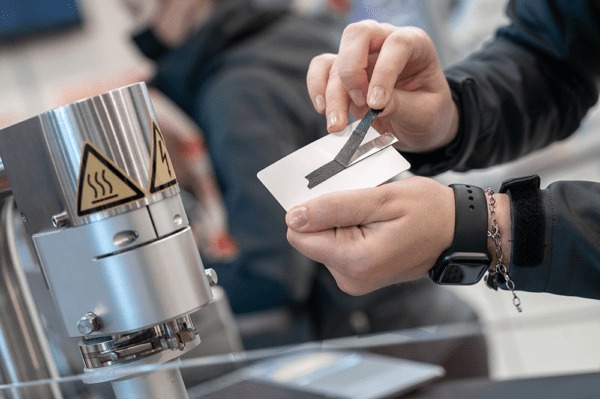
Almaak and HEXPOL TPE Collaborate On 2K Adhesion-Synchronised Materials
As the plastics industry meets at Fakuma 2023, the polymer compounders Almaak International and HEXPOL TPE announced a partnership optimising 2K material combinations tailored for automotive.
To meet functional, ergonomic, or aesthetic requirements, TPE materials are used for two-shot or over-moulding soft-touch overlays onto rigid substrates. The adhesion of standard TPE is limited to olefin-based substrates like polypropylene, which have limitations regarding heat and rigidity performance. However, chemically modified TPEs allow adhesion to a much wider range of engineering thermoplastics. They are enhancing property characteristics to meet more demanding component requirements.
Almaak’s products include PC/ABS, ABS, PC, ASA, PBT, PA6, PA6.6 and their blends, including materials with up to 100% recycled content. These adhesions were tested with HEXPOL TPE’s portfolio of thermoplastic elastomer materials.
Automotive applications include interior, exterior and technical parts such as seals, grips, trim, console and internal carrier, grommets, electronic housing, and noise and vibration dampening.
“TPE materials for multi-component processes need to be adhesion synchronised with substrates, especially polar technical thermoplastics”
Thomas Koppl, Group Product Manager, HEXPOL TPE. He went on to say:
“PBT is increasingly used for electromobility applications and has difficulty adhering to TPE. Glass fibre reinforcement and flame-retardant additives make it even more challenging. The collaboration between Almaak and HEXPOL TPE delivers tested material combinations that ensure chemical compatibility and adhesion performance”.
Figure 1: Example of 2K Moulding of PBT with TPE
The engineering thermoplastics and TPE combinations have been tested according to the VDI 2019 standard, which measures the adhesion between materials. TPE is moulded onto the thermoplastic and peeled off at a 90° angle. The required adhesion peel force is measured and describes the adhesion quality. Even for substrates which make bonding difficult, such as PBT, it is possible to get a good adhesion if the substrate and TPE are compatible. For example, Dryflex UV 65.01B220 TPE achieves an adhesion peel force of 3.3 N/mm on Anjacom PBT 455-GF30.
The support package offered by Almaak and HEXPOL TPE includes tooling and processing advice. This is because processing conditions (2K or insert moulding, temperature, injection speed) and tool design (geometry, adhesion area, flow length) can also impact adhesion performance.
“Through this collaboration, we offer the best solutions for combining hard plastics and soft TPE. It gives our automotive customers a great competitive advantage. Our material testing and development means customers will know that our materials function perfectly together.”
Volker Krebs, Almaak International
Contact HEXPOL to learn how you can reap the benefits of this partnership here.
+44 (0)161 342 1150
Email
Website







